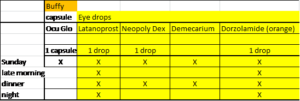Buffy, my 8 ½ year-old cocker spaniel, chased her squeaky tennis ball down the steps to the first floor while I brushed my teeth—a typical morning in my household. But when I came out of the shower a half hour later, she was bumping into the walls, into chairs, and into me. She was “non-visual” as her ophthalmologist says, or blind.

I knew this day would come, but not…
- the day before our Christmas caroling party where we hosted about thirty people;
- right before the Christmas holiday where I likely couldn’t get any treatment for her pain;
- when the house was a total mess with washing the living room rug and waxing the kitchen floor, so all the furniture was scattered around the house;
- when I had a zillion things to do.
But it could have been worse. It could have happened the next day, Saturday, the 23rd when Buffy’s ophthalmologist wasn’t available.
Timing is critical when eye pressure spikes with glaucoma. If it stays elevated for more than several hours, she would lose her sight. Glaucoma can occur suddenly in dogs, unlike with people where it takes years to develop.
Stage 1 – Diagnosis
Buffy’s glaucoma started the day after her first visit to an ophthalmologist on June 1st. He had not even mentioned that cocker spaniels are especially prone to glaucoma. Poor Buffy had suffered with a migraine headache that entire weekend, since the ophthalmologist had been too busy to see her and said her symptoms sounded like a scratched cornea when he returned my call at 5 pm. Buffy had acted listless, her right eye was red, and she squinted.
I should have taken her to my regular vet, who could always find the time to squeeze in an emergency—glaucoma is a medical emergency—at least for dogs. I finally did take Buffy to the vet on Monday when her condition wasn’t improving, which I thought it should from a scratched cornea.
By the time the ophthalmologist saw Buffy on June 6th, she was blind in her right eye. I didn’t know this since she easily compensated with her other eye. This is common when glaucoma initially strikes.
Stage 2 – Eye removal
In July, even with eye drops, the pressure in Buffy’s blind right eye was climbing. I decided to have it removed so she wouldn’t suffer while I was out of town for five days.
Buffy had tested positive for a genetic pre-disposition to the disease, so her ophthalmologist said that her left eye (fellow eye) would also suffer from the disease within 6 – 18 months. Eye drops for glaucoma are only effective for a short time with dogs, unlike with people who can take glaucoma medication for decades.
Stage 3 – Temporary blindness
In September, Buffy started bumping into things on a Sunday morning. I put her halo on to help her stop bumping into things, when my husband suggested giving her his glaucoma medicine (Latanoprost). Buffy had taken this medication before in her blind eye. Within an hour, Buffy stopped bumping into things and her sight had returned. At that time, her eye drops consisted of Dorzolamide (anti-glaucoma) twice a day and NeoPolyDexamethasone (antibiotic/anti-inflammatory) once a day in her remaining eye.
After this temporary blindness, the ophthalmologist gave me more eye medications (Latanoprost and Demecarium Bromide) and said that Buffy would lose her sight in a few weeks, maybe months.
Stage 4 – Almost blind
Now we are on borrowed time according to the ophthalmologist, and Buffy was bumping into things again on December 22nd. I feared that this was it. She was already on many doses of her eye medications with a total of ten drops per day. I figured all that was left was removing her eye which would reduce her pain.
A different ophthalmologist saw us after an hour and a half wait in the reception area. I sat there kicking myself that I had not brought Buffy’s eye medications and a book to read. When the receptionist said to come right in, I dropped everything and drove 45 minutes to get there. I had already given Buffy an extra dose of Latanoprost, but it had not helped this time.
Buffy’s eye pressure was 73. Normal is 20 or less. Anything over 35 causes pain. The first thing the ophthalmologist tried was giving 4 rounds of Latanoprost every five minutes. Why didn’t we do this while I was in the waiting room? I could have done this myself if they had given me the drops. Maybe doing this sooner could have saved her sight. But Buffy’s eye pressure had risen to 75 after the repeated dose of Latanoprost.
Two additional treatments were proposed.
- Place a fine needle into her eye and relieve the pressure. This doesn’t require anesthesia and takes only a few minutes. The risk is that this could cause inflammation.
- Do an IV infusion of Mannitol. Mannitol increases the osmotic concentration of the blood and dehydrates the vitreous humor (reducing the eye pressure). She would need a blood test to confirm that her kidneys were healthy. It takes about an hour or so to bring down the eye pressure—if it works.
I opted for the fine needle poke and it reduced Buffy’s eye pressure down to 7! By the time we got home, it seemed like maybe Buffy could see outlines or contrasts since she wasn’t bumping into things but she couldn’t find food dropped on the floor near her. The ophthalmologist also increased the dosage of several of Buffy’s eye drops—now she’s up to 12 eye drops per day!
The next day Buffy’s condition had not changed. Every test I could think of seemed to indicate that she was blind (waving a hand in front of her eye, throwing a toy or food near her), but she wasn’t really bumping into the walls any more.
I called my vet and scheduled Buffy’s eye removal surgery for the day after Christmas so that she wouldn’t have to suffer through these pressure spikes.
But was she totally blind?
I warned people at our party on the 23rd that Buffy was blind, but she didn’t bump into anyone and seemed perfectly comfortable walking around furniture and our thirty guests. Could her other senses reveal their presence or did she still have some residual vision? She still couldn’t see food dropped in front of her.
On Christmas Eve, my husband and I returned home at 11:30 pm after leaving Buffy home for about seven hours. Buffy acted very confused, walked cautiously, and bumped into things. We took her for a short walk to the park a few houses away and she walked in circles and acted dazed. She seemed more than blind, like she was in pain from a pressure spike. I gave her eye drops and some Tramadol, which the ophthalmologist had prescribed for pain, and went to bed.
On Christmas Day, Buffy was fine, not bumping into things and she didn’t act confused or in pain. We had sixteen people over for dinner and she didn’t bump into them or have difficulties with all the chairs, yet she still could not see food dropped in front of her nose.
Buffy’s surgery was scheduled for the 26th. But first, I wanted my vet to determine if Buffy could see a bit or was blind. Unfortunately, the ophthalmologist wasn’t available until January 8th, so my regular vet checked Buffy’s pressure, which was only 13. She also confirmed that Buffy still had a little bit of vision. So we postponed her surgery.
Lessons learned
- If you suspect your dog has a problem with her eyes and a specialist is not available, see your vet. Timing is critical and often your vet can get through to a specialist easier than you can.
- If your vet, or specialist, says to come in and they will squeeze you in between appointments, bring in all your medications since you may be sitting there for a while.
- For Latanoprost, you can go over the prescribed number of eye drops to relieve the eye pressure, if needed.
- Become educated. I thought I had, but Top 5 Glaucoma Drugs provided a lot more information and will allow me to ask my ophthalmologist about other drugs or combinations of drugs. According to this article, perhaps I should have started to use Demecarium bromide sooner in Buffy’s remaining eye to prolong the period before glaucoma would set in. I also want to ask about Dorzolamide mixed with Timolol, which seems like it could be more effective.
With luck, Buffy will continue to have some vision for a while before her eye needs removal and she becomes blind. I just hope it doesn’t happen over the New Year’s weekend.
Please leave a comment and subscribe to my blog in the top right corner.
This is a blog hop. Please visit the other blogs.



Happy New Year friend!
http://www.ruckustheeskie.com